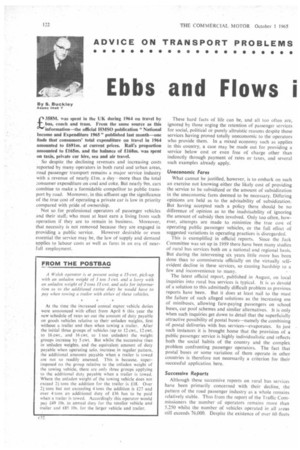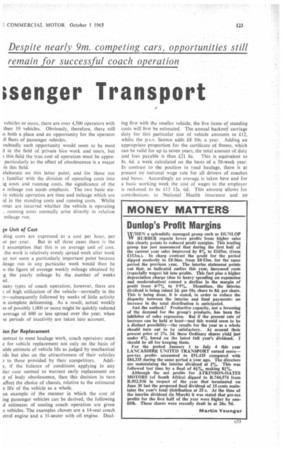Ebbs and Flows i isenger Transport
Page 124

Page 125

Page 126

If you've noticed an error in this article please click here to report it so we can fix it.
f358M. was spent in the UK during 1964 on travel by bus, coach and tram. From the same source as this information—the official HMSO publication " National Income and Expenditure 1965" published last month—one finds that consumers' total expenditure on travel in 1964 amounted to £691m. at current prices. Rail's proportion amounted to £165m. and the balance of £168m. was spent on taxis, private car hire, sea and air travel.
So despite the declining revenues and increasing costs reported by many operators in both rural and urban areas, road passenger transport remains a major service industry with a revenue of nearly il rn. a day—more than the total zonsumer expenditure on coal and coke. But nearly 9m. cars combine to make a formidable competitor to public transport by road. Moreover, in this affluent age the significance of the true cost of operating a private car is low in priority compared with pride of ownership.
Not so for professional operators of passenger vehicles and their staff, who must at least earn a living from such operation if they are to remain in business. Moreover, that necessity is not removed because they are engaged in
providing a public service. However desirable or even essential the service may be, the law of supply arid demand applies to labour costs as well as fare,, in an era of nearfull employment. These hard facts of life can be, and all too often are, ignored by those, urging the retention of passenger services for social, political or purely altruistic reasons despite those services having proved totally uneconomic to the operators who provide them. In a mixed economy such as applies in this country, a case may be made out for providing a service below cost or even free of charge other than indirectly through payment of rates or taxes, and several such examples already apply.
Uneconomic Fares
What cannot be justified, however, is to embark on such an exercise not knowing either the likely cost of providing the service to be subsidized or the amount of subsidization in the uneconomic fares deemed to be necessary. Differing opinions are held as to the advisability of subsidization. But having accepted such a policy there should be no difference of opinion as to the inadvisability of ignoring the amount of subsidy then involved. Only too often, however, attempts are made to minimize the true cost of operating public passenger vehicles, or the full effect of suggested variations in operating practices is disregarded.
This is exemplified in official reports. Since the Jack Committee was set up in 1959 there have been many studies of rural bus services both on a national and regional basis. But during the intervening six years little more has been done than to commiserate officially on the virtually selfevident decline in these services, so causing hardship to a few and inconvenience to many.
The latest official report, published in August, on local inquiries into rural bus services is typical. It is as devoid of a solution to this admittedly difficult problem as previous reports have been. But it does at least nail to the mast the failure of such alleged solutions as the increasing use of minibuses, allowing fare-paying passengers on school buses, car pool schemes and similar alternatives. It is only when such inquiries get down to detail that the superficially attractive possibility of postal buses—namely the combining of .postal deliveries with bus services—evaporates. In just such instances it is brought home that the provision of a public passenger service is highly individualistic and reflects both the social habits of the country and the complex problem confronting passenger operators. The fact that postal•buses or some variation of them operate in other countries is therefore not necessarily a criterion for their successful application here.
Successive Reports Although these successive reports on rural bus services have been primarily concerned with their decline, the pattern of the road passenger industry as a whole remains relatively stable. Thus from the report of the Traffic Commissioners the number of operators remains more than 5,250 whilst the number of vehicles operated in all areas still exceeds 76,000. Despite the existence of over 60 fleets vehicles or more, there are over 4,500 operators with than 10 vehicles. Obviously, therefore, there still is both a place and an opportunity for the operator .11 fleets of passenger vehicles.
oubtecily such opportunity would seem to be most d in the field of private hire work and tours, but this field the true. cost of operation must be appreparticularly as the effect of obsolescence is a major in this field.
elaborate on this latter point, and for those not familiar with the division of operating costs into ig costs and running costs, the significance of the
e mileage run needs emphasis. The two basic elein vehicle operation are time and mileage which are :d in the standing costs and running costs. Whilst rmer are incurred whether the vehicle is operating
• running costs normally arise directly in relation mileage run.
ge Unit of Cost
ding costs are expressed as a cost per hour, per
or per year. But in all three cases there is the I assumption that this is an average unit of cost. the work is relatively evenly spread week after week ay not seem a particularly important point because ileage run in any particular week would then be o the figure of average weekly mileage obtained by .g the yearly mileage by the number of weeks ad.
natty types of coach operation, however, there are s of high utilization of the vehicle—normally in the !..r—subsequently followed by weeks of little activity n complete delicensing. As a result, actual weekly es of possibly 1,000 or more might be quickly reduced average of 600 or less spread over the year, when se periods of inactivity are taken into account.
ion for Replacement
ontrast to most haulage work, coach operators must e for vehicle replacement not only on the basis of able estimate of vehicle life as judged by mechanical rds but also on the attractiveness of their vehicles a to those provided by their competitors. Addiy, if the balance of conditions applying in any dar case seemed to warrant early replacement on Lt of body obsolescence, then this decision in turn affect the choice of chassis, relative to the estimated
e life of the vehicle as a whole, an example of the manner in which the cost of ing passenger vehicles can be derived, the following d estimates of costing coach operation are given o vehicles. The examples chosen are a 14-seat coach etrol engine and a 31-seater with oil engine. Deal adjustment to permit holidays with pay. Incidentally, the item of wages in this instance is of particular importance in its effect on the total operating costs of small vehicles.
Rent and rates in respect of garaging the vehicle are nominally assessed at £1 7s. 6d., whilst insurance adds £1 6s. a week. Because of the overall increase in the costs of financing it is assumed that interest is charged at if per cent on the initial outlay of the vehicle which, for the example chosen, happens to be £1,227. This gives an equivalent interest charge per week of £1 16s. 10d.
Accordingly the total for the five items of standing costs amounts to £18 us. 4d. a week for this 14-seat coach or alternatively 106.09d. per hour.
Running Costs
Dealing now with the five items of running costs, it is assumed that petrol is purchased in bulk at 4s. 7d. a gallon and that a rate of consumption of 18 m.p.g. is maintained. This results in a fuel cost per mile of 3.06d. Lubricants are reckoned to add 0:2Id. and tyres 0.35d, per mile. This latter calculation is based on a mileage life per set of 30,000.
Maintenance is reckoned to cost 2.02d. per mile and depreciation 1.70d. a mile. Vehicle life is reckoned at 150,000 miles and in this particular case it is assumed that the average weekly mileage throughout the year is 600. If it had been less the cost of depreciation would have had to be decreased because of the effect of obsolescence as mentioned earlier. The total for the five items of running costs is therefore 7.34d. per mile. The addition of standing costs then gives a total operating cost; when averaging 600 miles a week with this I4-seat coach, of 14.77d. per mile or £36 18s. a week. If the average weekly mileage was only 200 (and even this could actually amount to 400 in the summer and none in the winter) then the total operating costs per mile would have been 31.40d. In contrast where the average weekly mileage was 1,000 the corresponding cost would be 11.80d.
31-seater Dealing similarly with the 31-seat coach fitted with oil engine the five items of standing costs per week are: licences 10s. 9d., wages £13 12s. 6d., rent and rates £1 10s. 9d.. insurance £1 19s. 2d. and interest £5 13s. Od. (on an outlay of £3,765). Total standing costs: £23 6s. 2d. a week or 133-19d. per hour.
Still assuming an average of 600 miles a week, the five items of running costs for this 31-seater are estimated as: fuel 3.72d.. lubricants 0-27d., tyres I.09d.. maintenance 2.56d., and depreciation 3.85d.: total 11.49d. per mile. Making the same addition as before of standing costs and running costs gives a total operating cost for this 31-seat coach fitted with oil engine of 20-81d, a mile or £52 Is. a week when an average of 600 miles a week is maintained_ At 200 miles a week the operating costs would be increased to 42.78d. a mile, and decreased to 17.08d. at 1,000 miles a week.
ing first with the smaller vehicle, the five items of standing costs will first be estimated. The annual hackneY carriage duty for this particular size of vehicle amounts to £12, whilst the p.s.v. licence adds £8 10s. a year Adding an appropriate proportion for the certificate of fitness, which can be valid for up to seven years, the total amount of duty
and fees payable is thus £21 6s. This is equivalent to 8s. 6d. a week calculated on the basis of a 50-week year. In contrast to the position in road haulage, there is at present no national wage rate for all drivers of coaches and buses. Accordingly an average is taken here and for a basic working week the cost of wages to the employer is reckoned to be £13 12s. 6d. This amount allows for contributions to National Health insurance and an












































































































































































